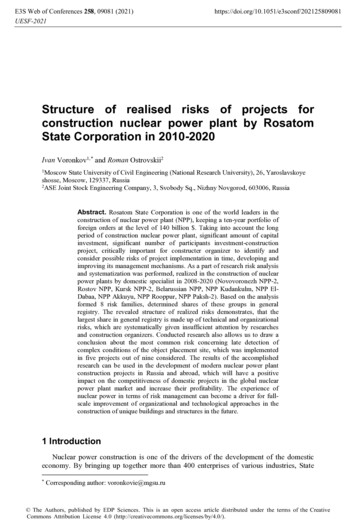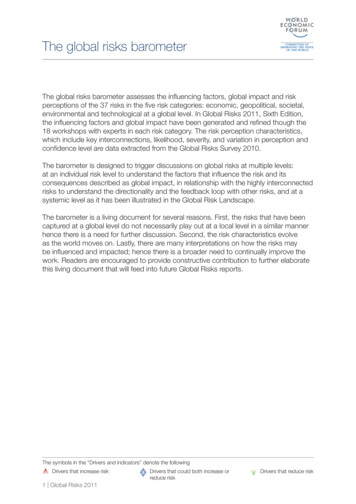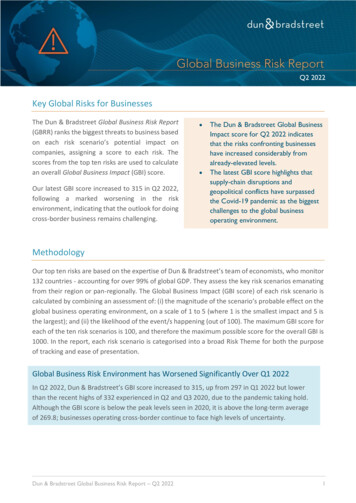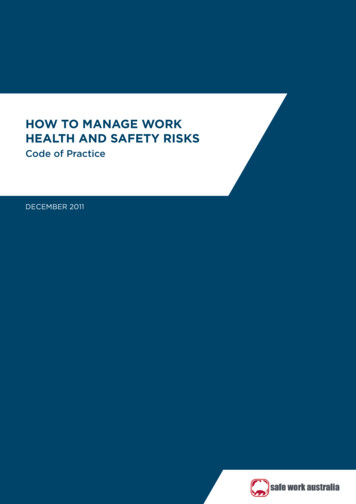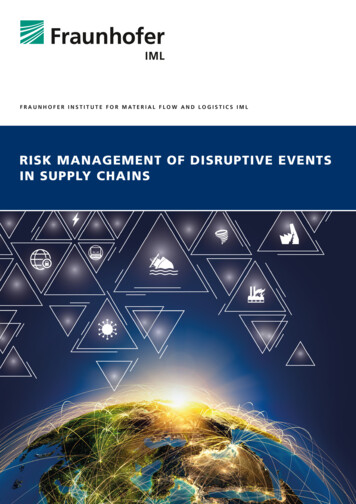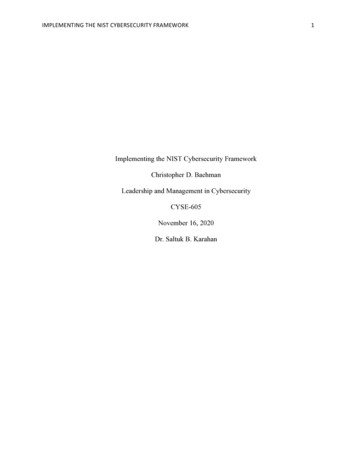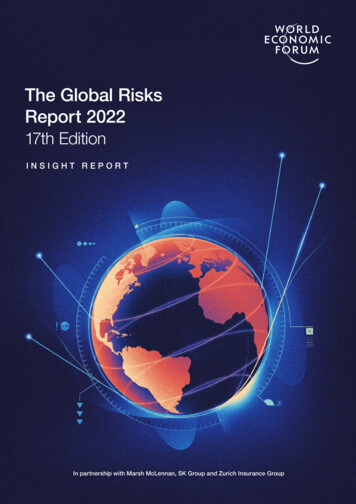
Transcription
The Global RisksReport 202217th EditionINSIGHT REPORTIn partnership with Marsh McLennan, SK Group and Zurich Insurance Group
The Global Risks Report 2022, 17th Edition, is published by theWorld Economic Forum.The information in this report, or on which this report is based, hasbeen obtained from sources that the authors believe to be reliableand accurate. However, it has not been independently verified andno representation or warranty, express or implied, is made as tothe accuracy or completeness of any information obtained fromthird parties. In addition, the statements in this report may providecurrent expectations of future events based on certain assumptionsand include any statement that does not directly relate to ahistorical fact or a current fact. These statements involve knownand unknown risks, uncertainties and other factors which are notexhaustive. The companies contributing to this report operatein a continually changing environment and new risks emergecontinually. Readers are cautioned not to place undue relianceon these statements. The companies contributing to this reportundertake no obligation to publicly revise or update any statements,whether as a result of new information, future events or otherwiseand they shall in no event be liable for any loss or damage arising inconnection with the use of the information in this report.World Economic Forum Cover artwork: SMOG 2022 – All rights reserved.All rights reserved. No part of this publication may be reproduced,stored in a retrieval system, or transmitted, in any form or by anymeans, electronic, mechanical, photocopying, or otherwise withoutthe prior permission of the World Economic Forum.ISBN: 978-2-940631-09-4The report and an interactive data platform areavailable at wef.ch/risks22
The Global RisksReport 202217th EditionStrategic PartnersMarsh McLennanSK GroupZurich Insurance GroupAcademic AdvisersNational University of SingaporeOxford Martin School, University of OxfordWharton Risk Management and Decision Processes Center, University of Pennsylvania
CONTENTSPreface5—6Executive Summary7—10CHAPTER 1Global Risks 2022:Worlds Apartincluding Global Risks Perception Survey2021–2022 Results11—29CHAPTER 2Disorderly Climate Transition30—44CHAPTER 3Digital Dependencies andCyber Vulnerabilities45—56CHAPTER 4Barriers to Migration57—69CHAPTER 5Crowding and Competitionin Space70—79CHAPTER 6Refreshing ResilienceAppendices80—91Appendix A: Description of Global Risks 2022Appendix B: Executive Opinion SurveyNational Risk PerceptionsAppendix C: Technical Notes: Global RisksPerception Survey 2021–2022Acknowledgements92—112113—116The Global Risks Report 20224
PrefaceBy Klaus Schwab and Børge BrendeA divergent economic recovery from the crisis createdby the pandemic risks deepening global divisions at atime when societies and the international communityurgently need to collaborate to check COVID-19, healits scars and address compounding global risks.and approaches within and between countries andthen examines the risks that could arise from suchtensions. This year’s report also highlights theimplications of these risks for individuals, governmentsand businesses.In some societies, rapid progress on vaccination, leapsforward on digitalization and a return to pre-pandemicgrowth rates herald better prospects for 2022 andbeyond. Others could be weighed down for years bystruggles to apply even initial vaccine doses, combatdigital divides and find new sources of economicgrowth. Widening disparities within and betweencountries will not only make it more difficult to controlCOVID-19 and its variants, but will also risk stalling, ifnot reversing, joint action against shared threats thatthe world cannot afford to overlook.The Global Risks Perception Survey (GRPS),which has underpinned the report since 2006,was refreshed this year to gather new and broaderinsights from nearly 1,000 global experts and leaderswho responded. The 2021-2022 GRPS includes thefollowing sections:Last year’s edition of the Global Risks Report warnedof potential knock-on economic risks that are nowclear and present dangers. Supply chain disruptions,inflation, debt, labour market gaps, protectionism andeducational disparities are moving the world economyinto choppy waters that both rapidly and slowlyrecovering countries alike will need to navigate torestore social cohesion, boost employment and thrive.These difficulties are impeding the visibility of emergingchallenges, which include climate transition disorder,increased cyber vulnerabilities, greater barriers tointernational mobility, and crowding and competitionin space.– COVID-19 Hindsight invites respondents toopine on the reverberations of the crisis, allowingcomparability with the results from the previous year.– Future Outlook captures respondent sentiment,informing our analysis of how individual contextsmay influence global risk perceptions andaffectmitigation.– Horizon captures respondents’ perceived trajectoryand sense of urgency of global risks, informing ouranalysis of choices and trade-offs that decisionmakers may face.– Severity ranks potential damage while Effectsasks respondents to consider cascadingimpacts in conjunction with the severity of therisk itself.Restoring trust and fostering cooperation withinand between countries will be crucial to addressingthese challenges and preventing the world from driftingfurther apart.– International Mitigation asks respondents toassess international efforts in 15 global governanceareas to identify achievements and areas ofopportunity for global action and cooperation.The 17th edition of the Global Risks Report identifiestensions that will result from diverging trajectories– Open questions on risks, trends and warningsigns source expert knowledge.The Global Risks Report 20225
This year the Global Risks Report also draws onthe views of over 12,000 country-level leaders whoidentified critical short-term risks to their 124 countries,gathered through the World Economic Forum’sExecutive Opinion Survey. The areas highlighted inthese responses are likely to inform national decisionmaking and provide a perspective on how short-termrisk national priorities may compare with global risksand perspectives.The report also draws from and supports the WorldEconomic Forum’s platforms dedicated to catalysinga new economy and society, accelerating climateaction for people and planet, leveraging FourthIndustrial Revolution technologies, stewarding industrytransformations and enhancing global and regionalcooperation. These platforms and their stakeholdersuse the insights from this report to shape their agendasfor tackling the world’s greatest challenges andembedding greater resilience and cooperation.We are ever grateful to our partners in the report’sdevelopment: Marsh McLennan, SK Group andZurich Insurance Group. We also thank our academicpartners: the National University of Singapore, theOxford Martin School at the University of Oxford andthe Wharton Risk Management and Decision ProcessesCenter at the University of Pennsylvania.This report continues to leverage the collectiveintelligence of an expanding community of theworld’s foremost risk experts, convened by theWorld Economic Forum’s Global Risks Practice: theGlobal Risks Report Advisory Board, the Chief RiskOfficers Community and the Global Future Councilon Frontier Risks, as well as a series of consultationswith regional and thematic experts from the public andprivate sectors.The Global Risks Report 20226
Executive SummaryAs 2022 begins, COVID-19 and its economic andsocietal consequences continue to pose a critical threatto the world. Vaccine inequality and a resultant uneveneconomic recovery risk compounding social fracturesand geopolitical tensions. In the poorest 52 countries—home to 20% of the world’s people—only 6% of thepopulation had been vaccinated at the time of writing. By2024, developing economies (excluding China) will havefallen 5.5% below their pre-pandemic expected GDPgrowth, while advanced economies will have surpassedit by 0.9%—widening the global income gap.The resulting global divergence will create tensions—within and across borders—that risk worsening thepandemic’s cascading impacts and complicating thecoordination needed to tackle common challengesincluding strengthening climate action, enhancing digitalsafety, restoring livelihoods and societal cohesion andmanaging competition in space.The Global Risks Report 2022 presents the results of thelatest Global Risks Perception Survey (GRPS), followedby an analysis of key risks emanating from currenteconomic, societal, environmental and technologicaltensions. The report concludes with reflections onenhancing resilience, drawing from the lessons of the lasttwo years of the COVID-19 pandemic. The key findingsof the survey and the analysis are summarized below.Global risks perceptions highlightsocietal and environmental concernsAsked to take a view of the past two years,respondents to the GRPS perceive societal risks—inthe form of “social cohesion erosion”, “livelihood crises”and “mental health deterioration”—as those that haveworsened the most since the pandemic began. Only16% of respondents feel positive and optimistic aboutthe outlook for the world, and just 11% believe theglobal recovery will accelerate. Most respondentsinstead expect the next three years to be characterizedby either consistent volatility and multiple surprises orfractured trajectories that will separate relative winnersand losers.For the next five years, respondents again signalsocietal and environmental risks as the mostconcerning. However, over a 10-year horizon,the health of the planet dominates concerns:environmental risks are perceived to be the five mostcritical long-term threats to the world as well as themost potentially damaging to people and planet,with “climate action failure”, “extreme weather”, and“biodiversity loss” ranking as the top three most severerisks. Respondents also signalled “debt crises” and“geoeconomic confrontations” as among the mostsevere risks over the next 10 years.Technological risks—such as “digital inequality” and“cybersecurity failure”—are other critical short- andmedium-term threats to the world according to GRPSrespondents, but these fall back in the rankingstowards the long term and none appear among themost potentially severe, signalling a possible blind spotin risk perceptions.The 2021-2022 GRPS included a question oninternational risk mitigation efforts. “Artificialintelligence”, “space exploitation”, “cross-bordercyberattacks and misinformation” and “migration andrefugees” are the areas where most respondentsbelieve the current state of risk mitigation efforts fallshort of the challenge—that is, efforts are “not started”or in “early development”. Meanwhile, for “tradefacilitation”, “international crime” and “weapons of massdestruction”, large majorities perceived risk mitigationefforts to be “established” or “effective”.The Global Risks Report 20227
REUTERS/HEO RANA divergent economic recoverythreatens collaboration onglobal challengesEconomic challenges flowing from the pandemicpersist. The outlook remains weak: at the time ofwriting, the global economy was expected to be2.3% smaller by 2024 than it would have beenwithout the pandemic. Rising commodity prices,inflation and debt are emerging risks. Moreover, withanother spike in COVID-19 cases towards the endof 2021, the pandemic continues to stifle countries’ability to facilitate a sustained recovery.The economic fallout from the pandemic is compoundingwith labour market imbalances, protectionism, andwidening digital, education and skills gaps that risksplitting the world into divergent trajectories. In somecountries, rapid vaccine rollout, successful digitaltransformations and new growth opportunities couldmean a return to pre-pandemic trends in the short termand the possibility of a more resilient outlook over alonger horizon. Yet many other countries will be heldback by low rates of vaccination, continued acutestress on health systems, digital divides and stagnantjob markets. These divergences will complicate theinternational collaboration needed to address theworsening impacts of climate change, manage migrationflows and combat dangerous cyber-risks.Short-term domestic pressures will make it harder forgovernments to focus on long-term priorities and willlimit the political capital allocated to global concerns.“Social cohesion erosion” is a top short-term threat in31 countries—including Argentina, France, Germany,Mexico and South Africa from the G20. Disparities thatwere already challenging societies are now expected towiden—51 million more people are projected to live inextreme poverty compared to the pre-pandemic trend—at the risk of increasing polarization and resentmentwithin societies. At the same time, domestic pressuresrisk stronger national interest postures and worseningfractures in the global economy that will come at theexpense of foreign aid and cooperation.A disorderly climate transition willexacerbate inequalitiesRespondents to the GRPS rank “climate action failure”as the number one long-term threat to the world andthe risk with potentially the most severe impacts overthe next decade. Climate change is already manifestingrapidly in the form of droughts, fires, floods, resourcescarcity and species loss, among other impacts. In2020, multiple cities around the world experiencedextreme temperatures not seen for years—such asa record high of 42.7 C in Madrid and a 72-year lowof -19 C in Dallas, and regions like the Arctic Circlehave averaged summer temperatures 10 C higherThe Global Risks Report 20228
than in prior years. Governments, businesses andsocieties are facing increasing pressure to thwart theworst consequences. Yet a disorderly climate transitioncharacterized by divergent trajectories worldwide andacross sectors will further drive apart countries andbifurcate societies, creating barriers to cooperation.Given the complexities of technological, economicand societal change at this scale, and the insufficientnature of current commitments, it is likely that anytransition that achieves the net zero goal by 2050 will bedisorderly. While COVID-19 lockdowns saw a global dipin greenhouse gas (GHG) emissions, upward trajectoriessoon resumed: the GHG emission rate rose faster in2020 than the average over the last decade. Countriescontinuing down the path of reliance on carbon-intensivesectors risk losing competitive advantage through ahigher cost of carbon, reduced resilience, failure to keepup with technological innovation and limited leverage intrade agreements. Yet shifting away from carbon-intenseindustries, which currently employ millions of workers,will trigger economic volatility, deepen unemploymentand increase societal and geopolitical tensions. Adoptinghasty environmental policies will also have unintendedconsequences for nature—there are still manyunknown risks from deploying untested biotechnicaland geoengineering technologies—while lack of publicsupport for land use transitions or new pricing schemeswill create political complications that further slow action.A transition that fails to account for societal implicationswill exacerbate inequalities within and between countries,heightening geopolitical frictions.Growing digital dependency willintensify cyberthreatsGrowing dependency on digital systems—intensifiedby COVID-19—has altered societies. Over the last 18months, industries have undergone rapid digitalization,workers have shifted to remote working where possible,and platforms and devices facilitating this change haveproliferated. At the same time, cybersecurity threats aregrowing—in 2020, malware and ransomware attacksincreased by 358% and 435% respectively—and areoutpacing societies’ ability to effectively prevent orrespond to them. Lower barriers to entry for cyberthreatactors, more aggressive attack methods, a dearth ofcybersecurity professionals and patchwork governancemechanisms are all aggravating the risk.Attacks on large and strategic systems will carrycascading physical consequences across societies,while prevention will inevitably entail higher costs.Intangible risks—such as disinformation, fraud andlack of digital safety—will also impact public trust indigital systems. Greater cyberthreats will also hampercooperation between states if governments continueto follow unilateral paths to control risks. As attacksbecome more severe and broadly impactful, alreadysharp tensions between governments impactedby cybercrime and governments complicit in theircommission will rise as cybersecurity becomes anotherwedge for divergence—rather than cooperation—amongnation-states.Barriers to mobility risk compoundingglobal insecurityGrowing insecurity resulting from economic hardship,intensifying impacts of climate change and politicalinstability are already forcing millions to leave theirhomes in search of a better future abroad. “Involuntarymigration” is a top long-term concern for GRPSrespondents, while 60% of them see “migration andrefugees” as an area where international mitigation effortshave “not started” or are in “early development”. In 2020,there were over 34 million people displaced abroadglobally from conflict alone—a historical high. However,in many countries, the lingering effects of the pandemic,increased economic protectionism and new labourmarket dynamics are resulting in higher barriers to entryfor migrants who might seek opportunity or refuge.These higher barriers to migration, and their spillover effect on remittances—a critical lifeline for somedeveloping countries—risk precluding a potentialpathway to restoring livelihoods, maintaining politicalstability and closing income and labour gaps. Atthe time of writing, the United States faced over11 million unfilled jobs in general and the EuropeanUnion had a deficit of 400,000 drivers just in thetrucking industry. In the most extreme cases,humanitarian crises will worsen since vulnerablegroups have no choice but to embark on moredangerous journeys. Migration pressures will alsoexacerbate international tensions as it is increasinglyused as a geopolitical instrument. Destinationcountry governments will have to manage diplomaticrelationships and immigrant skepticism amongtheir populations.Opportunities in space could beconstrained by frictionsWhile humans have been exploring space for decades,recent years have witnessed increased activity, notonly creating new opportunities but also signallingan emerging realm of risk, particularly with growingmilitarization and weaponization in the arena. NewThe Global Risks Report 20229
commercial satellite market entrants are disruptingincumbents’ traditional influence over the global spacecommons in delivering satellite services, notablyinternet-related communications. A greater numberand range of actors operating in space could generatefrictions if space exploration and exploitation are notresponsibly managed. With limited and outdatedglobal governance in place to regulate space alongsidediverging national-level policies, risks are intensifying.One consequence of accelerated space activity is ahigher risk of collisions that could lead to a proliferationof space debris and impact the orbits that hostinfrastructure for key systems on Earth, damagevaluable space equipment or spark internationaltensions. Limited governance tools increase thelikelihood of space activity escalating geopoliticaltensions, and recent weapons tests in spaceunderscore such risks. Increased space activity couldalso lead to unknown environmental impacts or raisecosts for public goods such as weather monitoring orclimate change surveillance.Year two of the pandemic yieldsinsights on resilienceIn 2021, countries deployed new mechanismsto respond to a public health crisis with shiftingcharacteristics, leading to both successes andREUTERS/MUHAMMAD HAMEDfailures. Two interlinked factors were critical foreffective management of the pandemic: first, thereadiness of governments to adjust and modifyresponse strategies according to changingcircumstances; and second, their ability to maintainsocietal trust through principled decisions andeffective communication.Reflecting on the distinct resilience goals ofgovernments, businesses and communities will helpensure that agendas are aligned in achieving a wholeof-society approach to tackling critical risks of anynature. For governments, balancing costs, regulatingfor resilience and adjusting data-sharing arrangementsto ensure sharper crisis management are key togalvanizing stronger interaction between public andprivate sectors. Businesses—recognizing that betternational-level preparedness is critical for planning,investing and executing their strategies—can leverageopportunities in areas such as supply chains, codesof conduct within their industry and inclusion of aresilience dimension into workforce benefit offerings.Communities can help local governments to joinup with national efforts, improve communicationand support grassroots resilience efforts. At anorganizational level, strategies such as groundingresilience analyses in key delivery requirements,appreciating systemic vulnerabilities and embracing adiversity of approaches can help leaders build betterresilience as well.The Global Risks Report 202210
CHAPTER 1Global Risks2022: WorldsApart6%vaccination rate in poorest 52 countries97%public debt-to-GDP in 202051 millionincrease in extreme poverty projections197countries aligned on the Glasgow Climate Pact84%of experts are worried or concerned aboutthe worldGETTY/ABSTRACT AERIAL ARTThe Global Risks Report 202211
A divergent recoveryAt the start of 2022, the COVID-19 crisisis still ongoing and its economic ructionscontinue to be felt. Disparities in progresson vaccination are creating a divergenteconomic recovery that risks compoundingpre-existing social cleavages andgeopolitical tensions. These tensions andthe economic overhang of the pandemicwill make it difficult to ensure a coordinatedand sufficiently rapid approach to globalchallenges—most notably climate change.Vaccination and accelerated digitalizationhave enabled some countries to recoverrapidly from the economic crisis createdby the COVID-19 pandemic, but manyothers are still struggling to avoid the worstconsequences. At the time of writing,half of the world’s population was stillunvaccinated,1 40% remained offline,2and only 35% of the world’s studentslived in countries where schools are fullyopen.3 Some 37% of respondents to thisyear’s Global Risks Perceptions Survey(GRPS) believe the world will follow afractured trajectory in the medium term,increasingly separating relative “winners”from “losers” of the COVID-19 crisis (seeFigure 1.1). By the time the GRPS wasconducted (see the Technical Notes inAppendix C), only 11% believed the globalrecovery would accelerate over the nextthree years.Economic, geopolitical, public health andsocietal fractures—which increase afterpandemics4—risk leading to divergentand delayed approaches to criticalchallenges facing people and planet:accelerating the green transition inresponse to climate change (see Chapter 2),coordinating against heightened digitalvulnerabilities (see Chapter 3), managingmobility and migration (see Chapter 4) andsafeguarding the next global commons:space (see Chapter 5).FIGURE 1.1“What is your outlook for the world over the next three years?”Negative scenariosPositive scenario10.7%Accelerating globalrecovery41.8%37.4%Consistently volatile withmultiple surprisesFractured trajectoriesseparating relativewinners and losers10.1%Progressive tippingpoints with increasingcatastrophic outcomesSource: World Economic Forum Global Risks Perception Survey 2021-2022The Global Risks Report 202212
FIGURE 1.2“How do you feel about the outlook for the ied12.1% 3.7%Source: World Economic Forum Global Risks Perception Survey 2021-2022Effective domestic and international actionon these challenges depends on restoringtrust within societies, galvanizing national andglobal leaders and finding new opportunitiesfor collaboration (see Chapter 6). Fully 84%of GRPS respondents were either concernedor worried about the outlook for the world(see Figure 1.2); lack of optimism couldcreate a vicious cycle of disillusionment andsocial unrest.A turbulent global contextThe pandemic persistsThe world continues to grapple with theeffects of COVID-19 on public health. Atthe start of 2022, 5.4 million deaths fromCOVID-19 had been reported globally, outof 282 million confirmed cases.5 Moreover,a significant proportion of those infected byCOVID-19 have long-lasting symptoms—some 10% show persistent ill health 12weeks after having the disease.6 COVID-19vaccination has progressed steadily butunevenly around the world. At the timeof writing, 50 countries had vaccinatedmore than 70% of their population,7 withsome now starting to receive boostershots, while the vaccination rate in thepoorest 52 countries—home to 20% ofthe world’s population—was still only 6%.8Potentially more infectious variants of thevirus—notably the new Omicron variant—along with waning immunity among thevaccinated and a continued high proportionof people who are unvaccinated meant thatthe number of new cases increased againtowards the end of 2021.9 Unsurprisingly,“infectious diseases” are still considereda critical short-term threat to the world inthe GRPS.The COVID-19 crisis has also had extensivecollateral health impacts, partly becauseother diseases were deprioritized. Thepandemic led to an additional 53 millioncases of major depression globally.10“Mental health deterioration” was one ofthe top five risks that GRPS respondentssaw as having deteriorated the mostduring COVID-19. The incidence of noncommunicable diseases—which cause41 million deaths every year, mostly inlow- and middle-income countries—has also worsened worldwide due totreatment delays caused by COVID-19.11Antimicrobial resistance caused nearly 2million deaths in 2020 and this numbermay increase—particularly for malaria andtuberculosis—because of the inappropriateuse of antibiotics to treat COVID-19.12 Thepandemic and its collateral health impactsThe Global Risks Report 202213
will continue to put pressure on healthsystems across the globe, widen healthinequalities between and within countries,create social frictions and weigh down longterm economic growth potential.Risks to economic recoveryThe global economic recovery from therecession caused by responses to theCOVID-19 pandemic continues but isslowing. After a contraction of 3.1% in 2020,global economic growth is expected to reach5.9% in 2021 and slow to 4.9% in 2022.13By 2024, the global economy is projectedto be 2.3% smaller than it would have beenwithout the pandemic.14 Risks to economicgrowth are considerable, including risks froma potential resurgence of COVID-19 as newvariants emerge. The previous edition ofthe GRPS identified “commodity shocks”,“price instability” and “debt crises” as criticalmedium-term concerns. These are alreadyemerging to some extent. At the time ofwriting, commodity prices had increasednearly 30% since end of 2020;15 they couldremain volatile because of growing tensionsbetween Europe and Russia, China’senergy shortage,16 continued supply chaindisruptions and transition challenges fromdisinvestment in fossil fuel reserves. Inflationhas accelerated in many countries as aresult of pandemic-related disruptions tosupply chains combined with resurgentconsumer demand and higher commodityprices. This will dampen consumersentiment—which has been fundamentalfor recovery—and will increase risksfrom central bank interest rate rises.17 Inadvanced and developing economies alike,higher prices and more expensive debtwould impact lower-income householdsespecially hard, while small and mediumsized enterprises (SMEs) that are still tryingto avoid bankruptcy would suffer fromweakening consumption.Moreover, sovereign debt has spikedbecause of the pandemic. Governmentdebt globally increased by 13 percentagepoints, to 97% of GDP, in 2020.18 Alreadystrained public finances in developingcountries are at heightened risk from debtdeleveraging19 and an appreciation ofthe US dollar—the US Dollar Index hadrisen 7% since the start of 2021.20 GRPSrespondents identified “debt crises” asa critical short- and medium-term threatto the world, and one of the mostpotentially severe risks over the nextdecade (see Figure 1.3). Debt overhangswill make it more difficult for countriesto deal with the economic impacts ofCOVID-19 and finance a socially just,net zero transition.FIGURE 1.3“Identify the most severe risks on a global scale over thenext 10 echnologicalClimate action failure6thInfectious diseases2ndExtreme weather7thHuman environmental damage3rdBiodiversity loss8thNatural resource crises4thSocial cohesion erosion9thDebt crises5thLivelihood crises1st10thGeoeconomic confrontationSource: World Economic Forum Global Risks Perception Survey 2021-2022The Global Risks Report 202214
GETTY/LIU JINEconomic divergenceCOVID-19 prompted a global recession,but stark differences in vaccination ratesbetween countries now risk leading to evengreater economic divergence than theyexperienced before the pandemic. A greaterprevalence of COVID-19 in low-vaccinationcountries than in high-vaccination oneswill weigh on worker availability andproductivity, disrupt supply chains andweaken consumption. Moreover, alower post-pandemic risk appetite in thevaccinated world—comprised mostly ofadvanced economies—could weakentheir investment in the non-vaccinatedworld. The economic disruption fromthe pandemic has also created strongerincentives in the vaccinated world toprioritize resilience over cost minimization.Governments and industries may now driveregional convergence at the expense ofglobal integration as they seek to minimizesupply
- Future Outlook captures respondent sentiment, informing our analysis of how individual contexts may influence global risk perceptions andaffect mitigation. - Horizon captures respondents' perceived trajectory and sense of urgency of global risks, informing our analysis of choices and trade-offs that decision-makers may face.



